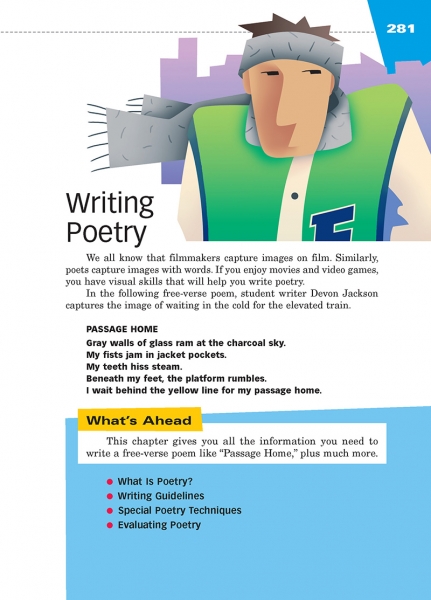Page 281 from

Start-Up Activity
Some students see poetry as a waste of time. Others write poetry as therapy. Obviously, if you can show students how poetry can empower them, they are much more likely to grab hold of it.
After reading the sample student poem on the page, present a few more lines from rapper (and poet) Tupac Shakur:
With all this extra stressing
The question I wonder is after death, after my last breath
When will I finally get to rest through this suppression?
They punish the people that’s asking questions
And those that possess, steal from the ones without possessions
The message I stress: to make it stop study your lessons
Don’t settle for less – even the genius asks his questions
Be grateful for blessings
Don’t ever change, keep your essence
Lead a discussion about the meaning of the quotation:
-
Which lines have the strongest impact on you?
-
How does Tupac use rhyme and near rhyme? (Note the stresses, both rhythmic and thematic, on all of these words: stressing, suppression, questions, possessions, lessons, blessing, and essence.)
-
How does Tupac use rhythm?
-
What is Tupac trying to say in this passage?
Use this discussion to help students realize that poetry isn't just for moldy old books. It's a form that lets all kinds of people express themselves.
Think About It
“Reality is wrong. Dreams are for real.”
—Tupac Shakur

Start-Up Activity
Some students see poetry as a waste of time. Others write poetry as therapy. Obviously, if you can show students how poetry can empower them, they are much more likely to grab hold of it.
After reading the sample student poem on the page, present a few more lines from rapper (and poet) Tupac Shakur:
With all this extra stressing
The question I wonder is after death, after my last breath
When will I finally get to rest through this suppression?
They punish the people that’s asking questions
And those that possess, steal from the ones without possessions
The message I stress: to make it stop study your lessons
Don’t settle for less – even the genius asks his questions
Be grateful for blessings
Don’t ever change, keep your essence
Lead a discussion about the meaning of the quotation:
-
Which lines have the strongest impact on you?
-
How does Tupac use rhyme and near rhyme? (Note the stresses, both rhythmic and thematic, on all of these words: stressing, suppression, questions, possessions, lessons, blessing, and essence.)
-
How does Tupac use rhythm?
-
What is Tupac trying to say in this passage?
Use this discussion to help students realize that poetry isn't just for moldy old books. It's a form that lets all kinds of people express themselves.
Think About It
“Reality is wrong. Dreams are for real.”
—Tupac Shakur

